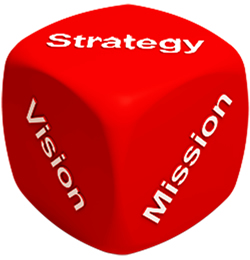Brian de Haaff* says that in a time of rapid change, the vision, mission and strategy that people adopt are the drivers which help them reach their destination.
 “You’ve got to think about big things while you’re doing small things, so that all the small things go in the right direction.”
“You’ve got to think about big things while you’re doing small things, so that all the small things go in the right direction.”
Futurist Alvin Toffler was writing about the effects of rapid technological change and popularised the phrase ‘information overload’.
The above quote in particular reinforces the importance of setting a strategic direction and mapping out your plan to take action.
Vision, mission and strategy are the drivers that help you reach your destination.
Vision is your forward-looking starting point — it establishes where you want your organisation to be in the future and why it matters.
Mission captures at a high level what you will do to realise your vision.
Strategy lays out the goals, big themes of work, and go-to-market approach that will help you achieve both the vision and mission.
Some people use the terms vision and mission interchangeably.
Or they may think of these higher-level concepts as a fluffy ideal that is not tied to daily work.
In fact, both are foundational to growth. Aspirational statements can be a rallying point for the team and a catalyst for real action.
Even leaders with a clear vision and mission may struggle with infusing the essence of both into the organisation’s DNA.
This is especially true in large organisations where there is less direct contact with the entire team.
Most days are filled with interruptions and time spent in meetings.
This is what makes vision, mission, and strategy so critical — you can bring the future into the everyday.
You just have to start thinking about vision, mission and strategy in practical terms. Let’s define these related concepts:
Vision is about the future. It is core to who you are and why you exist.
Vision helps the entire organisation understand that larger purpose.
Use plain language to ensure everyone grasps it. For example, our vision at Aha! is a world of lovable software.
This vision drives our culture and values and our strategic direction.
Vision is enduring, but not immutable. It should feel inspiring and fresh even as conditions and direction may change.
Make re-evaluation part of your strategic planning process.
Revisit it at least every few years or any time the organisation is undergoing major transformation.
Mission is what you will do or build to achieve your vision.
It puts your vision in pragmatic terms and helps guide strategy.
You can use it to define success and how you will differentiate yourself from others in the same market.
Our mission at Aha! is to help companies build software that their customers love.
Mission should be actionable and concrete.
Like vision, it should also be fairly static — with opportunities to realign when needed.
It should adapt as you launch new projects or experience periods of tremendous transformation.
Strategy is an operational plan
The measurable goals, high-level initiatives, and other work items that will help you achieve your vision and mission.
Setting strategy provides focus. These are guardrails for decisions about what you should work on now and what should wait.
Anything that moves you closer to your vision and mission should be prioritised.
Strategy is dynamic and should be revisited routinely.
We renew strategic initiatives every six months at Aha! The pace of change in today’s world requires this kind of responsiveness.
As your strategy shifts, refresh the roadmap that brings together the ‘why’, ‘what’ and ‘when’ of the current plans.
Even if you are not the person who defines your organisation’s vision and mission, you can still implement a brilliant strategy that serves both.
No matter where you sit in the organisation, it is your responsibility to make sure that the work you do has strategic importance.
Connecting your work to the vision, mission, and strategy is challenging and ongoing.
This is how you can find joy at work — bringing greater meaning to the tasks of each day.
How would you improve the vision, mission and strategy at your organisation?
*Brian de Haaff is the Chief Executive of cloud-based software company Aha! He can be contacted on Twitter @bdehaaff.
This article first appeared on the Aha! company website.











